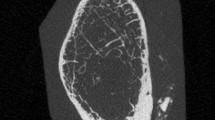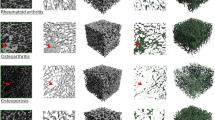Abstract
Osteophytes have been suggested to influence the bone mechanical properties. The aim of this study was to compare the microcrack density in osteophytes with that in the other parts of the osteoarthritic femoral neck (FN). The presence of microcracks was investigated in the ultra-distal FN and in the osteophytes in samples obtained during hip arthroplasty in 24 postmenopausal women aged 67 ± 10 years. Furthermore, the 3D microarchitecture and the collagen crosslinks contents were assessed by high-resolution peripheral quantitative computed tomography and high-performance liquid chromatography, respectively. Osteophytes were present in the 24 FN, mainly at the level of the inferior quadrant. Microcracks were present in all FN with an average of 2.8 per sample. All observed microcracks were linear. The microcrack density (Cr.N/BV; #/mm2) was significantly higher in cancellous than in cortical bone (p = 0.004), whereas the microcrack length (Cr.Le, µm) was significantly greater in cortical bone (p = 0.04). The collagen crosslinks ratio pyridinoline/deoxypyridinoline was significantly and negatively correlated with Cr.N/BV in the posterior (r′ = − 0.68, p = 0.01) and inferior (r′ = − 0.53, p = 0.05) quadrants. Microcracks were observed in seven osteophytes in seven patients. When microcracks were present in the osteophyte area, Cr.N/BV was also significantly higher in the whole FN and in the quadrant of the osteophyte compared to the cases without microcrack in the osteophyte (p < 0.03). In conclusion, in FN from hip osteoarthritis microcracks are present in all FNs but in only 23% of the osteophytes. The microcrack formation was greater and their progression was smaller in the cancellous bone than in the cortex. The spatial distribution of microcracks varied according to the proximity of the osteophyte, and suggests that osteophyte may influence microcrack formation related to changes in local bone quality.


Similar content being viewed by others
References
Gelse K, Söder S, Eger W, Diemtar T, Aigner T (2003) Osteophyte development—molecular characterization of differentiation stages. Osteoarthr Cartil 11:141–118. https://doi.org/10.1053/joca.2002.0873
van der Kraan PM, van den Berg WB (2007) Osteophytes: relevance and biology. Osteoarthr Cartil 15:237–244. https://doi.org/10.1016/j.joca.2006.11.006
Saha PK, Liang G, Elkins JM, Coimbra A, Duong LT, Williams DS, Sonka M (2011) A new osteophyte segmentation algorithm using partial shape model and its applications to rabbit femur anterior cruciate ligament transection via micro-CT imaging. IEEE Trans Biomed Eng. https://doi.org/10.1109/TBME.2011.2129519
Blain H, Chavassieux P, Portero-Muzy N, Bonnel F, Canovas F, Chammas M, Maury P, Delmas PD (2008) Cortical and trabecular bone distribution in the femoral neck in osteoporosis and osteoarthritis. Bone 43:862–868. https://doi.org/10.1016/j.bone.2008.07.236
Boutroy S, Vilayphiou N, Roux JP, Delmas PD, Blain H, Chapurlat RD, Chavassieux P (2011) Comparison of 2D and 3D bone microarchitecture evaluation at the femoral neck, among postmenopausal women with hip fracture or hip osteoarthritis. Bone 49:1055–1061. https://doi.org/10.1016/j.bone.2011.07.037
Rabelo GD, Roux JP, Portero-Muzy N, Gineyts E, Chapurlat R, Chavassieux P (2018) Cortical fractal analysis and collagen crosslinks content in femoral neck after osteoporotic fracture in postmenopausal women: comparison with osteoarthritis. Calcif Tissue Int 102:644-650. https://doi.org/10.1007/s00223-017-0378-9
Al-Rawahi M, Luo J, Pollintine P, Dolan P, Adams MA (2011) Mechanical function of vertebral body osteophytes, as revealed by experiments on cadaveric spines. Spine (Phila Pa 1976) 36:770–777. https://doi.org/10.1097/BRS.0b013e3181df1a70
Castaño-Betancourt MC, Rivadeneira F, Bierma-Zeinstra S, Kerkhof HJ, Hofman A, Uitterlinden AG, van Meurs JB (2013) Bone parameters across different types of hip osteoarthritis and their relationship to osteoporotic fracture risk. Arthritis Rheum 65:693–700. https://doi.org/10.1002/art.37792
Chavassieux P, Seeman E, Delmas PD (2007) Insights into material and structural basis of bone fragility from diseases associated with fractures: how determinants of the biomechanical properties of bone are compromised by disease. Endocr Rev 28:151–164. https://doi.org/10.1210/er.2006-0029
Qiu S, Rao DS, Fyhrie DP, Palnitkar S, Parfitt AM (2013) The morphological association between microcracks and osteocyte lacunae in human cortical bone. Bone 37:10–15. https://doi.org/10.1016/j.bone.2005.01.023
Mori S, Burr DB (1993) Increased intracortical remodeling following fatigue damage. Bone 14:103–109. https://doi.org/10.1016/8756-3282(93)90235-3
Vashishth D, Behiri JC, Bonfield W. Crack growth resistance in cortical bone: concept of microcrack toughening. J Biomech 30:763–769. https://doi.org/10.1016/S0021-9290(97)00029-8
Chapurlat RD, Delmas PD (2009) Bone microcrack: a clinical perspective. Osteoporos Int 20:1299–1308. https://doi.org/10.1007/s00198-009-0899-9
Portero-Muzy NR, Chavassieux PM, Arlot ME, Chapurlat RD (2011) Staining procedure for the detection of microcracks: application to ewe bone. Bone 49:917–919. https://doi.org/10.1016/j.bone.2011.07.001
Chappard D, Legrand E, Haettich B, Chales G, Auvinet B, Eschard JP, Hamelin JP, Basle MF, Audran M (2001) Fractal dimension of trabecular bone: comparison of three histomorphometric computed techniques for measuring the architectural two-dimensional complexity. J Pathol 195:515–521. https://doi.org/10.1002/path.970
Viguet-Carrin S, Gineyts E, Bertholon C, Delmas PD (2009) Simple and sensitive method for quantification of fluorescent enzymatic mature and senescent crosslinks of collagen in bone hydrolysate using single-column high performance liquid chromatography. J Chromatogr B 877:1–7. https://doi.org/10.1016/j.jchromb.2008.10.043
Seeman E, Delmas PD (2006) Bone quality—the material and structural basis of bone strength and fragility. N Engl J Med 354:2250–2261. https://doi.org/10.1056/NEJMra053077
Burr DB, Turner CH, Naick P, Forwood MR, Ambrosius W, Hasan MS, Pidaparti R (1998) Does microdamage accumulation affect the mechanical properties of bone? J Biomech 31:337–345. https://doi.org/10.1016/S0021-9290(98)00016-5
Tang T, Cripton PA, Guy P, McKay HA, Wang R (2018) Clinical hip fracture is accompanied by compression induced failure in the superior cortex of the femoral neck. Bone 108:121–131. https://doi.org/10.1016/j.bone.2017.12.020
Lotz JC, Cheal EJ, Hayes WC (1995) Stress distributions within the proximal femur during gait and falls: implications for osteoporotic fracture. Osteoporos Int 5:252–261
Diab T, Condon KW, Burr DB, Vashishth D (2006) Age-related change in the damage morphology of human cortical bone and its role in bone fragility. Bone 38:427–431. https://doi.org/10.1016/j.bone.2005.09.002
Nyman JS, Reyes M, Wang X (2005) Effect of ultrastructural changes on the toughness of bone. Micron 36:566–582. https://doi.org/10.1016/j.micron.2005.07.004
Courtney AC, Hayes WC, Gibson LJ (1996) Age-related differences in post-yield damage in human cortical bone. Exp Model J Biomech 29:1463–1471
Diab T, Vashishth D (2007) Morphology, localization and accumulation of in vivo microdamage in human cortical bone. Bone 40:612–618. https://doi.org/10.1016/j.bone.2006.09.027
Green JO, Wang J, Diab T, Vidakovic B, Guldberg RE (2011) Age-related differences in the morphology of microdamage propagation in trabecular bone. J Biomech 44:2659–2666. https://doi.org/10.1016/j.jbiomech.2011.08.006
Fazzalari NL, Forwood MR, Smith K, Manthey BA, Herreen P (1998) Assessment of cancellous bone quality in severe osteoarthrosis: bone mineral density, mechanics, and microdamage. Bone 22:381–388. https://doi.org/10.1016/S8756-3282(97)00298-6
Karim L, Vashishth D (2011) Role of trabecular microarchitecture in the formation, accumulation, and morphology of microdamage in human cancellous bone. J Orthop Res 29:1739–1744. https://doi.org/10.1002/jor.21448
Chapurlat RD, Arlot M, Burt-Pichat B, Chavassieux P, Roux JP, Portero-Muzy N, Delmas PD (2007) Microcrack frequency and bone remodeling in postmenopausal osteoporotic women on long-term bisphosphonates: a bone biopsy study. J Bone Miner Res 22:1502–1509. https://doi.org/10.1359/jbmr.070609
Follet H, Farlay D, Bala Y, Viguet-Carrin S, Gineyts E, Burt-Pichat B, Wegrzyn J, Delmas P, Boivin G, Chapurlat R (2013) Determinants of microdamage in elderly human vertebral trabecular bone. PLoS ONE 8:e55232. https://doi.org/10.1371/journal.pone.0055232
Mohsin S, O’Brien FJ, Lee TC (2006) Osteonal crack barriers in ovine compact bone. J Anat 208:81–89. https://doi.org/10.1111/j.1469-7580.2006.00509.x
Bernhard A, Milovanovic P, Zimmermann EA, Hahn M, Djonic D, Krause M, Breer S, Püschel K, Djuric M, Amling M, Busse B (2013) Micro-morphological properties of osteons reveal changes in cortical bone stability during aging, osteoporosis, and bisphosphonate treatment in women. Osteoporos Int 24:2671–2680. https://doi.org/10.1007/s00198-013-2374-x
Dooley C, Tisbo P, Lee TC, Taylor D (2012) Rupture of osteocyte processes across microcracks: the effect of crack length and stress. Biomech Model Mechanobiol 11:759–766. https://doi.org/10.1007/s10237-011-0349-4
Viguet-Carrin S, Garnero P, Delmas PD (2006) The role of collagen in bone strength. Osteoporos Int 17:319–336. https://doi.org/10.1007/s00198-005-2035-9
Banse X, Sims TJ, Bailey AJ (2002) Mechanical properties of adult vertebral cancellous bone: correlation with collagen intermolecular cross-links. J Bone Miner Res 17:1621–1628. https://doi.org/10.1359/jbmr.2002.17.9.1621
Oni OO, Morrison CJ (1998) The mechanical ‘quality’ of osteophytes. Injury 29:31–33. https://doi.org/10.1016/S0020-1383(97)00122-8
Acknowledgements
The author Gustavo Davi Rabelo thanks “Ciência sem Fronteiras—Conselho Nacional de Desenvolvimento Científico e Tecnológico/Brasil” (Processos: 245336/2012-5 e 301588/2014-7) for the scholarship.
Author information
Authors and Affiliations
Contributions
PC and RC designed the study. GDR and PC were evolved in all phases of the study and in writing the manuscript. NPM, EG, and JPR contributed to the experimental work and drafting the results. PC and RC are guarantors of the data. All authors revised and approved the final version of the manuscript and the decision to submit the manuscript for publication.
Corresponding author
Ethics declarations
Conflict of interest
Gustavo Davi Rabelo, Nathalie Portero-Muzy, Evelyne Gineyts, Jean-Paul Roux, Roland Chapurlat, and Pascale Chavassieux declare that they have no conflict of interest.
Human and Animal Rights and Informed Consent
All procedures performed in studies involving human participants were in accordance with the ethical standard of the institutional and/or national research committee and with the 1964 Helsinki declaration and its later amendments or comparable ethical standards. The study was approved by the research ethics committee, and written informed consent to participation in the study was obtained for all women.
Rights and permissions
About this article
Cite this article
Rabelo, G.D., Portero-Muzy, N., Gineyts, E. et al. Spatial Distribution of Microcracks in Osteoarthritic Femoral Neck: Influence of Osteophytes on Microcrack Formation. Calcif Tissue Int 103, 617–624 (2018). https://doi.org/10.1007/s00223-018-0456-7
Received:
Accepted:
Published:
Issue Date:
DOI: https://doi.org/10.1007/s00223-018-0456-7




